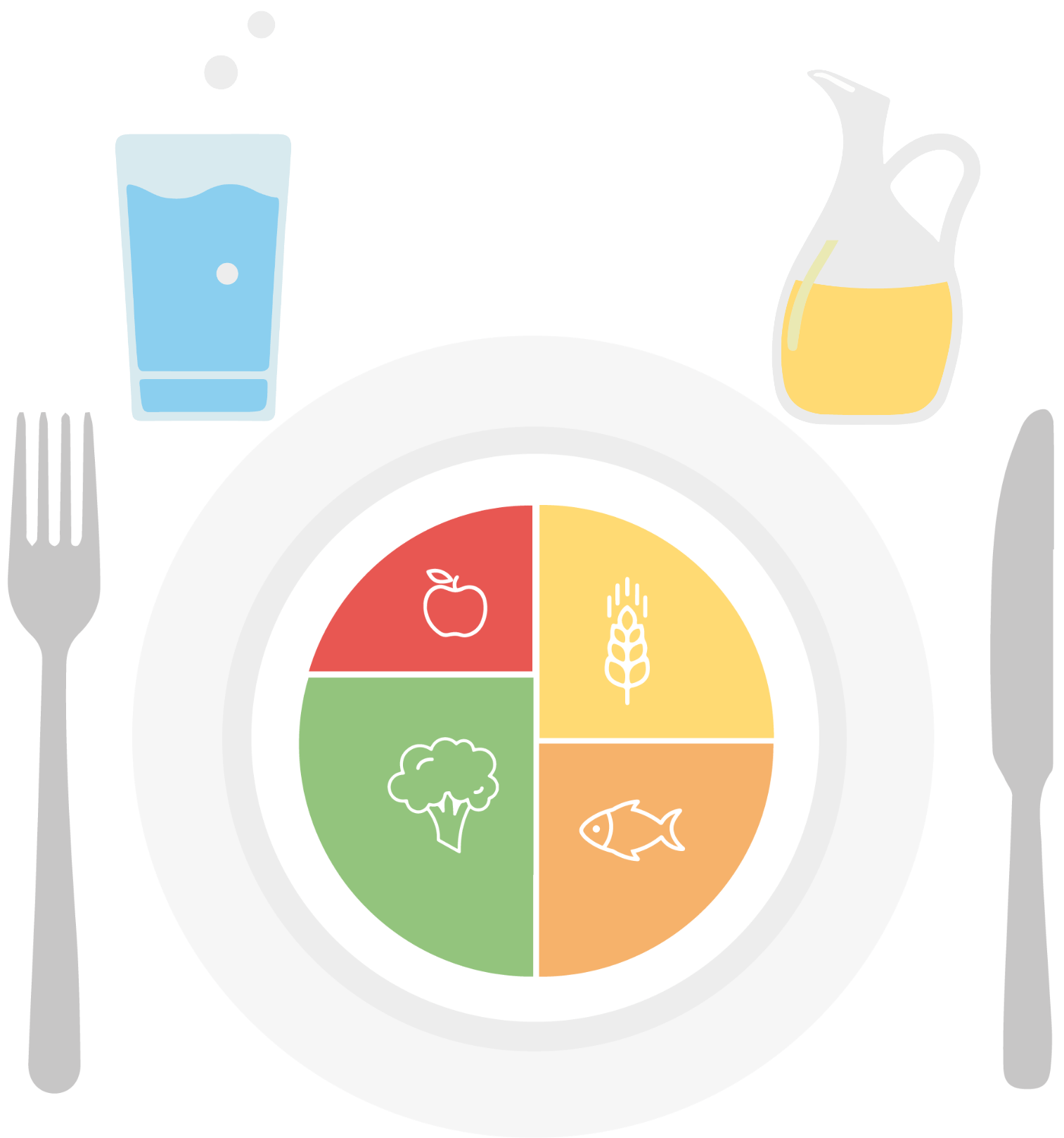Healthy eating
It is proven that people who eat healthy live longer on average. Correct eating habits are an important part of the prevention of civilization diseases such as heart and blood vessel diseases, type 2 diabetes and obesity and many others. A healthy diet is one of the principles of a healthy lifestyle. Here you will learn what a diet should look like that is beneficial for the health of your body and soul.
- The obesity rate among adults in the Czech Republic has increased significantly over the past 15 years.
- In the Czech Republic, approximately 19% of the population is obese, making the Czech Republic one of the worst countries in the European Union. By 2030, approximately 35% are predicted to be obese.
- 20% of fifteen-year-olds are overweight or obese.
Healthy plate

Vegetables and fruits - ½ plate
- Eat at least 5 portions a day - 3 vegetables and 2 fruits. Vegetables and fruits should make up about half of the plate. You can imagine one portion as roughly the size of a fist or a medium-sized apple.
- Vegetables and fruits are an important source of vitamins, minerals, water and antioxidants. If you have a varied and balanced diet, supplementation is not necessary.
- It is better to eat them fresh, but don't be afraid to vary the types of treatment. Try to include fermented species, which also have a positive effect on the intestinal microbiome. Limit the consumption of juices or smoothies.
Whole grain cereals - ¼ plate
- Cereals are a representative of carbohydrates. In this part of the plate we can include, for example, whole grain or rye bread, brown rice, quinoa or whole grain pasta and oatmeal. Some breakfast cereals can also be included here, but watch out for the amount of added sugar.
- Why choose whole grain foods over white bread, rice or pasta? The cereal grain is enclosed in a husk, which contains all the vitamins and minerals - without the husk (white bread) it disappears. At the same time, they are a source of a higher amount of fiber and this is also the reason why we should prefer them.
Quality proteins - ¼ plate
- High-quality protein sources include meat, fish, eggs, milk and milk products, as well as legume products such as tofu and tempeh, as well as other plant-based protein sources, such as seitan or robi.
- It's not meat like meat. The preferred source should be lean meat, such as chicken and turkey. On the other hand, limit red and fatty meat (beef, pork, veal) and avoid processed meat products (salami, hot dogs, sausages and sausages). Try to limit your consumption of red meat to an average of 1-2 servings per week. Excessive consumption of red meat and especially meat products is associated with an increased risk of colon and rectal cancer and, due to the significant content of cholesterol, salt and fat, also with an increased risk of developing atherosclerosis with subsequent heart attack or stroke. In addition, processed meat products and sausages contain additives and also a large amount of salt, the consumption of which should be kept to a minimum.
Fats
- It is important to remember that fat is an integral part of our diet. What matters most is the type of fat you eat. Choose foods with healthy, unsaturated fats (fish, seeds and healthy vegetable oils). Limit foods rich in saturated fat (especially fatty meats, butter, coconut and palm oil) and avoid unhealthy trans fat.
- Use vegetable oils such as virgin olive, canola or peanut oil. Eat butter and use it occasionally.
Fluids
- Of fluids, water should always be the drink of choice for any occasion. It's sugar-free and it's easy to carry a refillable bottle with you and refill it from the nearest tap.
You can also include unsweetened teas, which are especially pleasant in the winter months. Limit juice consumption to one glass a day and avoid sugary drinks.
Exercise
- Movement is part of a healthy plate. Don't forget to move regularly, ideally 30 minutes 5 times a week. Even a healthy plate is not complete without physical activity.
What is the Takehome message?
"Stay sane. Think about what you eat, but at the same time consider the facts, don't be tempted by colorful packaging, what your favorite YouTuber or influencer says, a trend or a good-sounding advertisement. From time to time, feel free to indulge in a cake or a meal from fast food and remember that one meal will not ruin the whole menu, but it won't save it either. And you know what, the main thing is not to go crazy."
More about food
The diet consists of macronutrients - proteins, fats and carbohydrates (sugars) and micronutrients - vitamins, minerals. Macronutrients need to be taken in a lot, because they are a source of calories and therefore energy. Micronutrients are sufficient for us in small amounts, but they are no less important, as they participate in important processes in our body.
What macronutrients should you eat the most and why? The acceptable ratio of macronutrients in the diet is:
- 45-65% of calories from carbohydrates
- 20-35% from fat
- 10-35% from protein
Carbohydrates are the most important source of energy for our body, so don't skip them. More important than the ratio of nutrients received is the quality of the foods that contain these nutrients.

